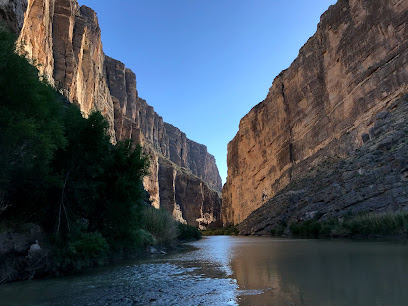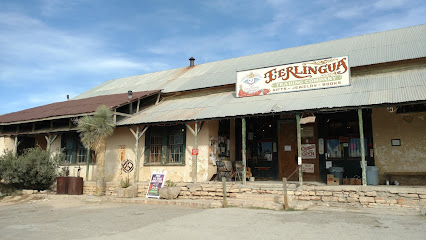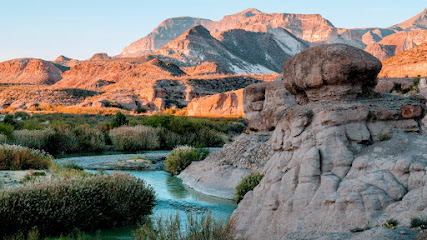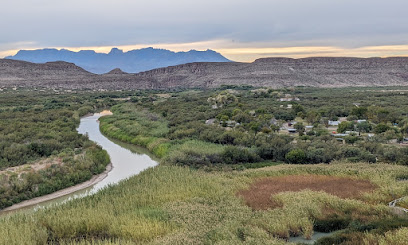
Big Bend National Park: Nature's Untamed Frontier
Explore the rugged beauty and diverse ecosystems of Big Bend National Park, where the Rio Grande forms a natural boundary and history comes alive in the vast Texas wilderness.
Big Bend National Park is a gem tucked away in the remote stretches of West Texas. This vast, rugged landscape offers an unparalleled experience for nature lovers, adventure seekers, and those looking to escape the hustle and bustle of city life. The park is named after the large bend in the Rio Grande River, which forms a natural boundary between the United States and Mexico. The park boasts diverse ecosystems, ranging from the arid Chihuahuan Desert to the lush riverbanks of the Rio Grande. Visitors can explore more than 150 miles of hiking trails, where they may encounter a variety of wildlife, including javelinas, roadrunners, and even the occasional mountain lion. Bird watchers will be delighted by the park's status as one of the most diverse birding areas in the United States. In addition to its natural beauty, Big Bend National Park is rich in cultural history. The area has been inhabited for thousands of years, and visitors can find evidence of Native American rock art, historic ranches, and even fossilized dinosaur remains. Whether you are rafting down the Rio Grande, stargazing under some of the darkest skies in the country, or simply soaking in the hot springs, Big Bend offers a unique and unforgettable experience.
Local tips in Big Bend National Park
- Visit in spring or fall for the most comfortable weather, as summer temperatures can be extremely high.
- Carry plenty of water and sun protection, as the park's desert environment can be harsh.
- Make sure to bring a map and a GPS, as cell service is limited in the park.
- Check the park's schedule for ranger-led programs that offer deeper insights into the park's natural and cultural history.
- If planning to camp, make reservations well in advance, especially during peak seasons.
- Don't miss the Santa Elena Canyon for a stunning view of sheer limestone cliffs rising from the river.
Big Bend National Park: Nature's Untamed Frontier
Big Bend National Park is a gem tucked away in the remote stretches of West Texas. This vast, rugged landscape offers an unparalleled experience for nature lovers, adventure seekers, and those looking to escape the hustle and bustle of city life. The park is named after the large bend in the Rio Grande River, which forms a natural boundary between the United States and Mexico. The park boasts diverse ecosystems, ranging from the arid Chihuahuan Desert to the lush riverbanks of the Rio Grande. Visitors can explore more than 150 miles of hiking trails, where they may encounter a variety of wildlife, including javelinas, roadrunners, and even the occasional mountain lion. Bird watchers will be delighted by the park's status as one of the most diverse birding areas in the United States. In addition to its natural beauty, Big Bend National Park is rich in cultural history. The area has been inhabited for thousands of years, and visitors can find evidence of Native American rock art, historic ranches, and even fossilized dinosaur remains. Whether you are rafting down the Rio Grande, stargazing under some of the darkest skies in the country, or simply soaking in the hot springs, Big Bend offers a unique and unforgettable experience.
When is the best time to go to Big Bend National Park?
Unmissable attractions to see
Panther Junction Visitor Center
Discover the essential hub for exploring Big Bend National Park at Panther Junction Visitor Center, your gateway to adventure and natural beauty.

Panther Junction Visitor Center
Explore Big Bend National Park's Panther Junction Visitor Center, your gateway to adventure and knowledge in the heart of Texas's stunning landscapes.

Chisos Mountains Lodge
Experience the breathtaking beauty of Big Bend National Park from the comfort of Chisos Mountains Lodge, the perfect retreat for outdoor enthusiasts.

Chisos Basin Visitor Center
Explore the Chisos Basin Visitor Center, your gateway to the breathtaking landscapes and rich wildlife of Big Bend National Park.

Chisos Basin Visitor Center
Discover the beauty of Big Bend from the Chisos Basin Visitor Center, your gateway to unforgettable adventures and stunning landscapes.

Fossil Discovery Exhibit
Discover the hidden treasures of the past at the Fossil Discovery Exhibit in Big Bend National Park, where ancient fossils tell the story of a vibrant world long gone.

Big Bend Ranch State Park
Discover the breathtaking landscapes and diverse wildlife at Big Bend Ranch State Park, Texas' largest state park, perfect for outdoor adventures and serene escapes.

Chisos Basin Campground
Experience the breathtaking beauty and tranquility of Chisos Basin Campground in Big Bend National Park, a haven for outdoor enthusiasts and nature lovers.

Santa Elena Canyon
Experience the breathtaking beauty of Santa Elena Canyon, a stunning natural wonder in Texas, perfect for hiking, photography, and wildlife spotting.

Mule Ears Viewpoint
Experience the breathtaking landscapes of Mule Ears Viewpoint in Big Bend National Park, a must-see for nature lovers and adventure seekers.

Rio Grande Village Nature Trail
Explore the breathtaking Rio Grande Village Nature Trail in Big Bend National Park, where stunning landscapes and diverse wildlife await every adventurer.

Rio Grande Village Nature Trail
Discover the breathtaking beauty of the Rio Grande Village Nature Trail in Big Bend National Park, a hiker's paradise amidst stunning landscapes.

Ross Maxwell Scenic Drive
Discover breathtaking vistas and diverse ecosystems along Ross Maxwell Scenic Drive in Big Bend National Park, Texas.

Sam Nail Ranch
Explore Sam Nail Ranch in Big Bend National Park: A historic gem offering stunning views, rich history, and a chance to connect with nature.

Chisos Mountains
Discover the breathtaking Chisos Mountains in Texas - a paradise for hikers, wildlife lovers, and stargazers within Big Bend National Park.

Markets, malls and hidden boutiques
Panther Junction Visitor Center
Discover the beauty of Big Bend National Park at Panther Junction Visitor Center, your essential hub for exploration and adventure.

Chisos Mountains Lodge
Experience the natural beauty of Big Bend National Park from the comfort of Chisos Mountains Lodge, your gateway to adventure and relaxation.

Chisos Basin Visitor Center
Explore the Chisos Basin Visitor Center, the ideal starting point for your adventure in Big Bend National Park, rich in nature and history.

Espresso Y Poco Mas
Discover the charming Espresso Y Poco Mas, where exceptional coffee meets delightful breakfasts in the heart of Terlingua, Texas.

Fossil Discovery Exhibit
Explore ancient Texas at the Fossil Discovery Exhibit, a captivating journey through prehistoric life nestled in Big Bend National Park.

Terlingua Trading Company
Explore Terlingua Trading Company, a unique gift shop and historical landmark offering local crafts, souvenirs, and a taste of Texas culture.

Cottonwood General Store
Discover local treasures and essential supplies at Cottonwood General Store in Terlingua, Texas, your gateway to Big Bend adventures.

Far Flung Outdoor Center
Discover adventure and tranquility at Far Flung Outdoor Center, where thrilling outdoor activities meet cozy comfort in the heart of Texas.

Shot Time Liquors
Explore Terlingua's favorite liquor store, offering a diverse selection of beverages and a friendly atmosphere for all visitors.

Many Stones
Explore the captivating Many Stones Rock Shop in Terlingua, where nature's treasures meet local artistry in a unique shopping experience.

Rio Grande Village Nature Trail
Discover the stunning Rio Grande Village Nature Trail in Big Bend National Park - a perfect hiking destination for all nature lovers seeking adventure and tranquility.

Desert Sports
Explore the breathtaking landscapes of Terlingua, TX with Desert Sports - your go-to shop for outdoor adventures, rentals, and tours.

ALON Gas Station
Discover convenience at ALON Gas Station in Terlingua, your essential stop for fuel and supplies while exploring Texas's breathtaking landscapes.

Little Burro Country Store
Explore the Little Burro Country Store in Alpine, Texas, your one-stop shop for groceries, camping supplies, and local craft beer amidst stunning West Texas landscapes.

Castolon Store
Experience the charm of Castolon Store in Big Bend National Park, where local history meets modern convenience amidst stunning desert landscapes.

Essential bars & hidden hideouts
Big Bend National Park
Explore the breathtaking landscapes and rich history of Big Bend National Park, a true natural wonder in Texas offering endless adventure.

Starlight Theatre
Savor the rich flavors of Mexico at Starlight Theatre, Terlingua's premier Mexican restaurant with live entertainment and vibrant atmosphere.

Chili Pepper Cafe
Experience authentic Mexican cuisine at Chili Pepper Cafe in Terlingua, where every meal bursts with flavor and warmth.

Chisos Mountains Lodge
Discover the stunning beauty of Big Bend National Park at Chisos Mountains Lodge, where comfort meets adventure in a breathtaking natural setting.

High Sierra Bar & Grill
Experience the perfect blend of rustic charm and culinary delights at High Sierra Bar & Grill in Terlingua, Texas.

Espresso Y Poco Mas
Discover the charm of Espresso Y Poco Mas, a delightful coffee shop in Terlingua offering artisan brews and delicious breakfast options in a cozy atmosphere.

DB's Rustic Iron BBQ
Experience the heart of Texas barbecue at DB's Rustic Iron BBQ in Terlingua, where flavor meets tradition in a rustic setting.

Big Bend Station
Experience adventure and relaxation at Big Bend Station – your gateway to the beauty of Terlingua and Big Bend National Park.

Chisos Basin Campground
Discover the breathtaking beauty and serenity of Chisos Basin Campground in Big Bend National Park, the perfect escape for outdoor enthusiasts.

La Kiva Restaurant & Bar
Discover La Kiva Restaurant & Bar, a vibrant spot in Terlingua, Texas, offering delicious meals and refreshing drinks in a relaxed setting.

Chisos Mountains Lodge Restaurant
Experience exquisite American cuisine with breathtaking views at Chisos Mountains Lodge Restaurant in Big Bend National Park.

Long Draw Pizza
Experience the authentic taste of Terlingua at Long Draw Pizza, where delicious flavors and stunning landscapes come together for an unforgettable dining experience.

Brick Vault Brewery and Barbecue
Experience the authentic taste of Texas barbecue and craft beer at Brick Vault Brewery and Barbecue in Marathon, Texas.

The Summit at Big Bend
Discover the unique cave accommodations at The Summit at Big Bend, where adventure meets luxury in the heart of Texas's stunning desert landscape.

Bad Rabbit Cafe @ Terlingua Ranch Lodge
Discover the charm of American cuisine at Bad Rabbit Cafe, a cozy eatery nestled in the stunning landscapes of Terlingua, Texas.

Local Phrases about Big Bend National Park
-
- HelloHowdy
[haw-dee] - GoodbyeAdios
[ah-dee-ohs] - YesYep
[yep] - NoNope
[nohp] - Please/You're welcomePlease/You're welcome
[Please/You're welcome] - Thank youThank you
[Thank you] - Excuse me/SorryPardon me
[par-dn me] - How are you?Howdy
[haw-dee] - Fine. And you?Fine. And you?
[Fine. And you?] - Do you speak English?Do you speak English?
[Do you speak English?] - I don't understandI don't understand
[I don't understand]
- HelloHowdy
-
- I'd like to see the menu, pleaseI'd like to see the menu, please
[I'd like to see the menu, please] - I don't eat meatI don't eat meat
[I don't eat meat] - Cheers!Cheers!
[Cheers!] - I would like to pay, pleaseI would like to pay, please
[I would like to pay, please]
- I'd like to see the menu, pleaseI'd like to see the menu, please
-
- Help!Help!
[Help!] - Go away!Go away!
[Go away!] - Call the Police!Call the Sheriff!
[Call the Sheriff!] - Call a doctor!Call a doctor!
[Call a doctor!] - I'm lostI'm lost
[I'm lost] - I'm illI'm sick
[I'm sick]
- Help!Help!
-
- I'd like to buy...I'd like to buy...
[I'd like to buy...] - I'm just lookingI'm just looking
[I'm just looking] - How much is it?How much is it?
[How much is it?] - That's too expensiveThat's too expensive
[That's too expensive] - Can you lower the price?Can you lower the price?
[Can you lower the price?]
- I'd like to buy...I'd like to buy...
-
- What time is it?What time is it?
[What time is it?] - It's one o'clockIt's one o'clock
[It's one o'clock] - Half past (10)Half past (10)
[Half past (10)] - MorningMorning
[Morning] - AfternoonAfternoon
[Afternoon] - EveningEvening
[Evening] - YesterdayYesterday
[Yesterday] - TodayToday
[Today] - TomorrowTomorrow
[Tomorrow] - 11
[1] - 22
[2] - 33
[3] - 44
[4] - 55
[5] - 66
[6] - 77
[7] - 88
[8] - 99
[9] - 1010
[10]
- What time is it?What time is it?
-
- Where's a/the...?Where's a/the...?
[Where's a/the...?] - What's the address?What's the address?
[What's the address?] - Can you show me (on the map)?Can you show me (on the map)?
[Can you show me (on the map)?] - When's the next (bus)?When's the next (bus)?
[When's the next (bus)?] - A ticket (to ....)A ticket (to ....)
[A ticket (to ....)]
- Where's a/the...?Where's a/the...?
History of Big Bend National Park
-
The earliest known inhabitants of the Big Bend region were Native American tribes, including the Chisos, Apache, and Comanche. These tribes utilized the land for its resources, living in harmony with the natural environment. Archaeological evidence, such as rock art and tools, provides a glimpse into their daily lives and spiritual practices. The pictographs and petroglyphs found throughout the park are testament to their long-standing presence in the area.
-
In the 16th century, Spanish explorers ventured into the region, driven by the quest for gold and a desire to spread Christianity. The Spanish established missions and attempted to convert the indigenous peoples, though with limited success. The influence of Spanish culture is still evident today in place names and historical artifacts scattered throughout the park.
-
The Comanche Trail is a historic trade route that traversed through what is now Big Bend National Park. Used primarily by the Comanche tribe, this trail facilitated trade between the Great Plains and Mexican markets. The trail also served as a route for raids and migrations, playing a significant role in the cultural and economic interactions of the region.
-
During the early 20th century, the Mexican Revolution had a profound impact on the Big Bend region. Refugees and revolutionaries crossed the Rio Grande, seeking safety and support. The rugged terrain provided a strategic advantage for both sides, and several skirmishes and battles took place within the area now encompassed by the park. This period left a lasting mark on the cultural landscape of Big Bend.
-
Big Bend National Park was established on June 12, 1944, following years of advocacy by local citizens and conservationists. The park's creation aimed to preserve the unique ecological and geological features of the region. Today, it spans over 800,000 acres and includes diverse landscapes such as deserts, mountains, and river ecosystems. The park's establishment marked a significant achievement in the conservation movement in the United States.
-
In recent decades, Big Bend National Park has been the focus of various conservation efforts aimed at protecting its unique biodiversity and cultural heritage. Programs to reintroduce native species, combat invasive plants, and preserve archaeological sites are ongoing. These efforts ensure that future generations can continue to enjoy and learn from this remarkable natural and historical treasure.
Big Bend National Park Essentials
-
Big Bend National Park is located in the southwestern part of Texas, United States. The nearest airports are Midland International Air and Space Port (approximately 235 miles away) and El Paso International Airport (approximately 325 miles away). From these airports, you can rent a car to drive to the park. Driving is the most practical option, as public transportation options are limited. The park is accessible via U.S. Route 385 from the north and U.S. Route 90 from the east and west.
-
Within Big Bend National Park, the most convenient way to get around is by car. The park is vast, covering over 800,000 acres, so having a vehicle will allow you to explore its many attractions, such as the Chisos Basin, Santa Elena Canyon, and Rio Grande Village. There are no public transportation services within the park itself. Biking and hiking are also popular ways to explore the park, but make sure you are well-prepared for the rugged terrain and extreme weather conditions.
-
The currency used in Big Bend National Park, as well as the rest of the United States, is the U.S. Dollar (USD). Credit and debit cards are widely accepted at the park's visitor centers, campgrounds, and stores. However, it is advisable to carry some cash, especially if you plan to visit more remote areas or small towns outside the park where card payment options might be limited. ATMs are available in nearby towns like Alpine and Terlingua.
-
Big Bend National Park is generally a safe destination for tourists. However, it is essential to take precautions due to the park's remote location and harsh environment. Always carry plenty of water, wear appropriate clothing and footwear, and inform someone of your travel plans. While crime rates targeting tourists are low within the park, it is always wise to secure your belongings and be aware of your surroundings. Never approach or feed wildlife.
-
In case of an emergency, dial 911 for immediate assistance. The park has a ranger station that can provide help in emergencies, and there are medical facilities in nearby towns like Alpine. It is highly recommended to have travel insurance that covers medical emergencies. For minor health issues, there are first aid supplies available at the park's visitor centers. Always carry a map, a compass, and a fully charged mobile phone when exploring the park.
-
Fashion: Do wear weather-appropriate and comfortable clothing, including sturdy hiking boots. Avoid wearing sandals or flip-flops on trails. Religion: Do respect the diverse cultural heritage and historic sites within the park. Public Transport: Don't expect to find public transportation within the park; plan to drive or bike. Greetings: Do greet fellow hikers and park visitors with a friendly nod or hello. Eating & Drinking: Do carry out all trash and food waste; don't leave any litter behind. Always follow Leave No Trace principles to preserve the park's natural beauty.
-
To experience Big Bend National Park like a local, consider visiting during the off-peak seasons (fall and winter) to avoid the crowds and extreme heat. Engage with park rangers and local guides who can provide insider knowledge about the best trails and hidden gems. Don't miss the stunning night sky, as Big Bend is one of the best places in the U.S. for stargazing. For a unique experience, visit the Terlingua Ghost Town nearby and enjoy a meal at the Starlight Theatre Restaurant and Saloon.
Nearby Cities to Big Bend National Park
-
Things To Do in San Angelo
-
Things To Do in Laredo
-
Things To Do in El Paso
-
Things To Do in Fredericksburg
-
Things To Do in White Sands
-
Things To Do in Roswell
-
Things To Do in Las Cruces
-
Things To Do in Abilene
-
Things To Do in Monterrey
-
Things To Do in New Braunfels
-
Things To Do in Lubbock
-
Things To Do in Ruidoso
-
Things To Do in Austin
-
Things To Do in Killeen
-
Things To Do in Truth or Consequences













